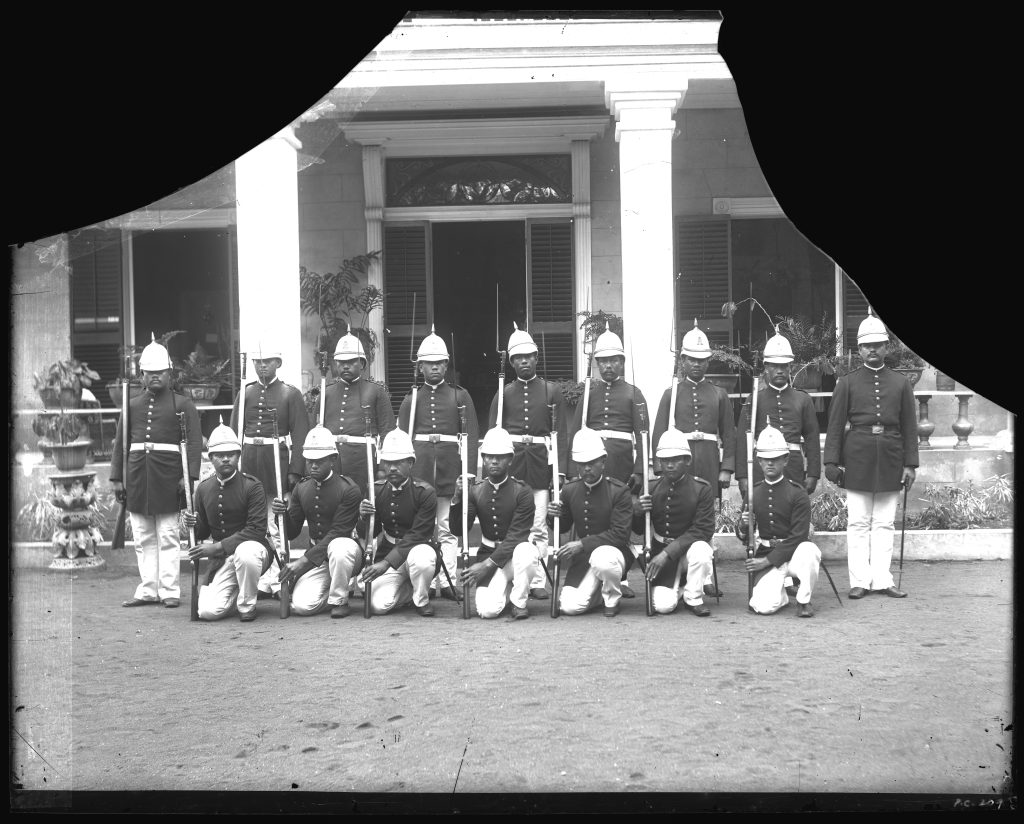1874 – 1893 King’s Guard / Queen’s Guard / Royal Guard / Household Troops

1854
A few months before his death in 1854, Kamehameha III completely reorganized the military system of the Islands. This was made law by “An Act, to Establish a Militia for the Hawaiian Islands.” It was the purpose of this act to combine all the military forces of the kingdom into one serviceable unit, so that it might function quickly and efficiently in time of need. It was the first occasion on which a definite plan had been made for the control of Hawaii’s military forces.
According to this plan, the Militia was divided into three groups. The first group consisted of young men from 18 to 22 years of age. From it were enlisted the regular troops, that is, the King’s Guard and the Artillery Detachment. The second group was composed of men from 22 to 30 years of age who had already served in the regular forces. This constituted the organized reserve, which was to be called to active service when needed. The men in this class were compelled to form themselves into companies and drill regularly. The third group consisted of men from 30 to 40 years of age who had served in the second class. They were to be called to active duty only in case of a national emergency. All three groups were to be armed and paid by the government.
When this act went into effect the two volunteer companies that had been formed in 1852 became inactive as they felt that the new act guaranteed a well-organized military force for the kingdom. Unfortunately, Kamehameha III died several months after the passage of this act and the new
– History of the Hawaii National Guard pp. 15
king never actively put it into effect. In a few years the army was in worse shape than before. The Artillery Detachment was placed on inactive status and the King’s Guard reduced to about fifty men.



1872
Prince Lunalilo announced that he was the highest chief and should become king. David Kalakaua denied his claims, but was unable to prevent the legislature from electing Lunailo king in 1873. It is not known to what extent Kalakaua was implicated in the matter, but Lunalilo became suspicious of the loyalty and intentions of the Household Troops.” In the early part of September, 1873, a riot occurred at the Barracks and the soldiers got out of hand. Fearing for his own safety, Lunalilo disbanded the entire regular force, with the exception of the Band, on September 12, 1873, and made no attempt to organize a new guard. Several days later he also disbanded the Honolulu Rifles and the Leleiohoku Guard.
– History of the Hawaii National Guard pp. 17


1874
This incident showed King Kalakaua the necessity of having a strong and loyal military force at his command and he immediately began the reorganization of the troops that had been disbanded the year before by LuInalilo. He instructed Attorney General Hartwell to organize a palace guard of fifty men to be known as the King’s Guard. This was to be the regular force of the kingdom and was to be directly responsible to the king. It was organized in 1874 and continued its existence until disbanded in 1893, but
– History of the Hawaii National Guard pp. 17
contemporaneous accounts are unanimous in declaring that it was always poorly drilled, poorly equipped and generally unreliable.
1884
Something more has to be done beyond the appropriation of public funds to provide for the King’s Guard •… The military force, as it now stands, is composed of one regularly paid company, the King’s Guard, consisting of 58 men, rank and file, and four volunteer companies exhibited on paper.
– History of the Hawaii National Guard pp. 19
1889
Suddenly on the morning of July 20, 1889, Wilcox with about one hundred and fifty followers took
– History of the Hawaii National Guard pp. 21
possession of the Government Building and the Palace Grounds. The King’s Guard was aware of the proposed attack and remained neutral in the Barracks. Lt. Robert Parker, in command of the King’s Guard, rounded up a band of men loyal to the king and they prevented the revolutionists from entering the Palace.
1893
The queen’s forces, consisting of some fifty Household Troops and the Police, were aware of the situation but took no action.
– History of the Hawaii National Guard pp. 26


At the same time Captain Sam Nowlein, commander of the Queen’s troops at the Barracks, reported to President Dole and officially surrendered. He asked for orders and was instructed to keep his men and arms in the Barracks that evening and not to post a guard as usual. . .
The following day, the 18th, Colonel Soper informed the volunteers that they were to remain on active duty as long as they were needed and that they would be paid by the government for every day’s duty, to recompense them for time lost from their business. That evening the Queen’s troops were paid off and disbanded,
– History of the Hawaii National Guard pp. 29

When the queen had abdicated her throne she had been allowed to keep at the expense of the government a small guard from the former Household Troops, consisting of Captain Nowlein, one sergeant, three corporals and twelve privates. Due to her intrigue with the British, the government I decided to disband this guard. Consequently, on February 27th, the Queen’s Guard was drawn up, paid off and dismissed, and its equipment handed over to Colonel Soper.
– History of the Hawaii National Guard pp. 35